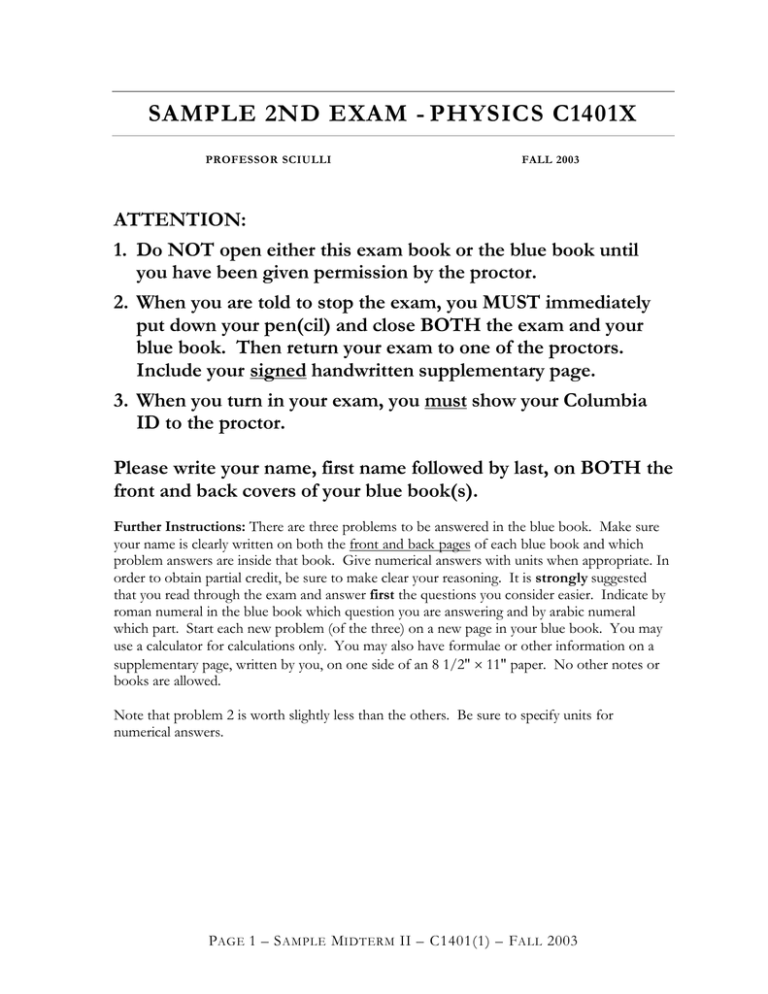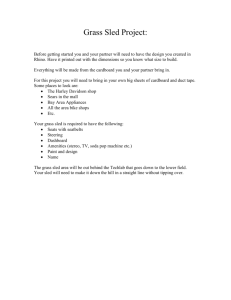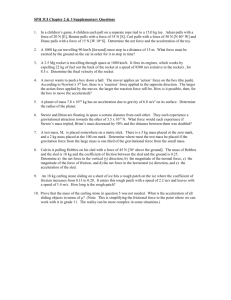SAMPLE 2ND EXAM - PHYSICS C1401X
advertisement

SAMPLE 2ND EXAM - PHYSICS C1401X PROFESSOR SCIULLI FALL 2003 ATTENTION: 1. Do NOT open either this exam book or the blue book until you have been given permission by the proctor. 2. When you are told to stop the exam, you MUST immediately put down your pen(cil) and close BOTH the exam and your blue book. Then return your exam to one of the proctors. Include your signed handwritten supplementary page. 3. When you turn in your exam, you must show your Columbia ID to the proctor. Please write your name, first name followed by last, on BOTH the front and back covers of your blue book(s). Further Instructions: There are three problems to be answered in the blue book. Make sure your name is clearly written on both the front and back pages of each blue book and which problem answers are inside that book. Give numerical answers with units when appropriate. In order to obtain partial credit, be sure to make clear your reasoning. It is strongly suggested that you read through the exam and answer first the questions you consider easier. Indicate by roman numeral in the blue book which question you are answering and by arabic numeral which part. Start each new problem (of the three) on a new page in your blue book. You may use a calculator for calculations only. You may also have formulae or other information on a supplementary page, written by you, on one side of an 8 1/2" × 11" paper. No other notes or books are allowed. Note that problem 2 is worth slightly less than the others. Be sure to specify units for numerical answers. P AGE 1 – S AMPLE MIDTERM II – C1401(1) – F ALL 2003 Generally usable constant g = 9.8 m/s2 Useful formulae for moments of inertia about axis through the center of mass. Sphere (radius R ) I = 25 MR 2 Disk or thin cylinder (radius R ) about central diagonal I = 41 MR 2 about central axis Thin Rod (length L ) I = 21 MR 2 I = 1 12 ML2 Problem I – 35 points A H=100 m B C Maria, on her sled, decides to slide down the snow-covered hill shown in the figure. She and her sled have a total mass of 75 kg. She starts at rest from point A and reaches the position B on level ground, which is H=100 meters lower. The distance along the path of the sled is LAB=500 meters. 1. (6 pt) Assuming there is no friction between her sled and the ground, find her speed when she reaches point B. 2. (10 pt) Suppose now there is friction along the path between A and B, and the speed of the sled at B is measured to be vB=35m/s. Find the average friction force over the path. 3. (9 pt) Assuming the same average friction force on the level surface as on the hill, find how far she travels before she stops at point C. 4. (10 pt) Suppose instead that, as the sled passes point B, a friend with weight equal to Maria+sled jumps into the sled. How fast are they moving immediately afterwards? Assuming the average friction force also doubles, how far do they travel to where they stop (distance from B to C)? P AGE 2 – S AMPLE MIDTERM II – C1401(1) – F ALL 2003 V2 Problem II – 30 points θ v0 θ V1 A rocket of mass, m=1000 kg , and velocity, v0 = 100 m/s, is traveling in some region of space when it explodes. It fragments into two pieces, each with half of the original rocket mass and each traveling at angle θ = 600 to the initial direction, as shown in the figure. 1. (5 pt) What is the initial kinetic energy of the rocket? 2. (10 pt) What are the speeds of each piece immediately after the explosion? 3. (10 pt) Find an expression for the ratio of the energy generated by the explosion to the initial kinetic energy in terms of some or all of the givens (m , v0 . and θ ). 4. (5 pt) How much energy (joules) is generated for the given numerical values of the parameters? ______________________________________________________________________ Problem III – 35 points Give the answers to each part in terms of some or all of the given parameters: M, L, m, and v. The figure shows an apparatus consisting of a long rod, length L and mass M , with a massive wooden block of equal mass, M , attached rigidly to the bottom end of the rod. (The block is small enough to be considered a point mass.) The apparatus hangs vertically from the point A, about which it is free to rotate. Initially the apparatus is at rest. A bullet of mass, m, traveling to the right with speed, v, imbeds itself in the block. 1. (9 pt) Find the moment of inertia about point A of the apparatus after the bullet has hit. 2. (6 pt) Find the angular momentum of the bullet (before it hit) relative to the point A. 3. (8 pt) Find the angular velocity of the rod immediately after the bullet hits and imbeds itself in the block. 4. (5 pt) Find the velocity of the block at the same time. 5. (7 pt) How high vertically does the block ultimately rise in its swing? End of Exam P AGE 3 – S AMPLE MIDTERM II – C1401(1) – F ALL 2003

